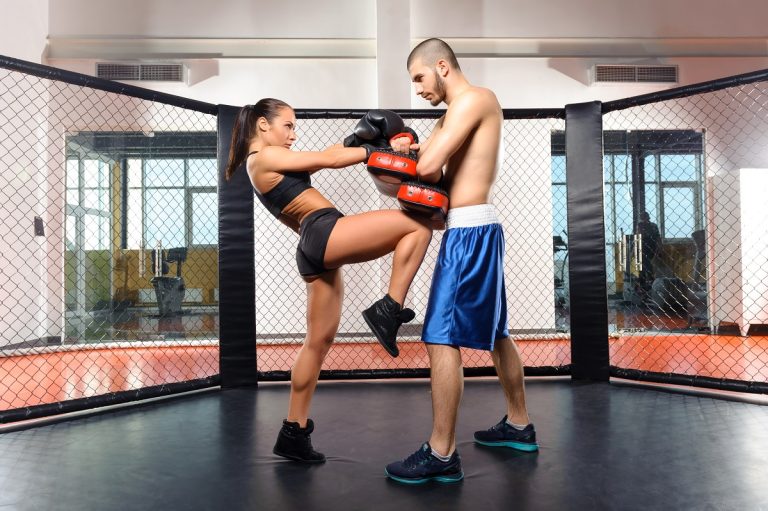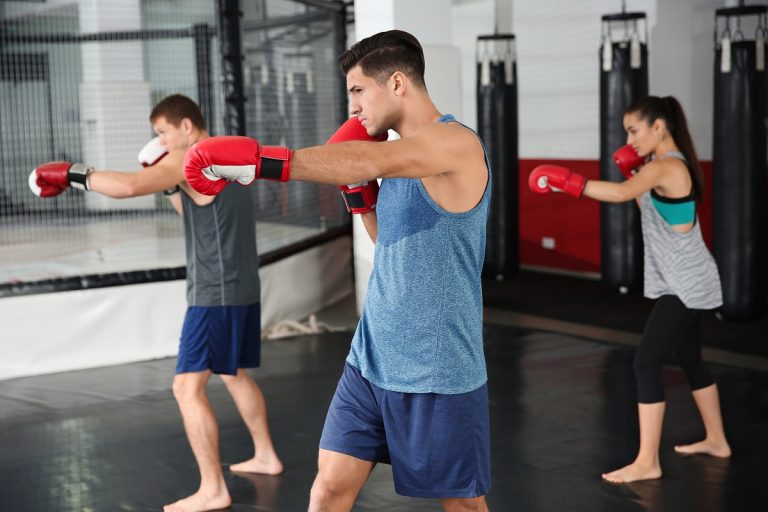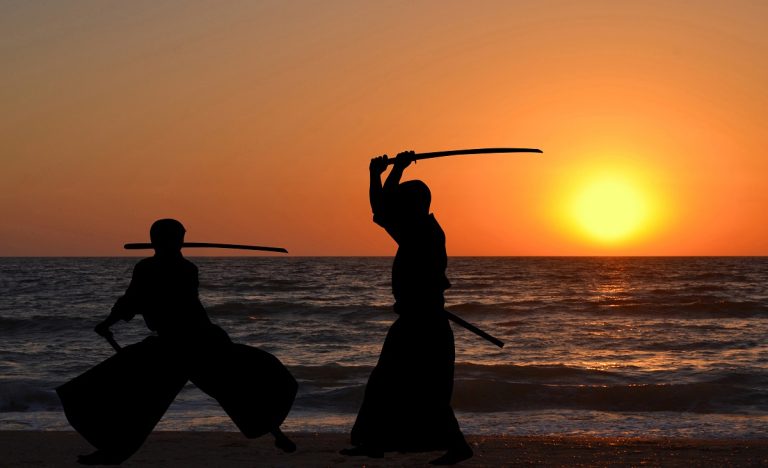3 Most Effective Martial Arts For Multiple Attackers (MMA, Boxing And Krav Maga)
When it comes to the best martial art for multiple attackers, the key elements to look out for are variety of moves and both standing and ground fighting forms. It needs to be something with which you can attack and defend equally as effectively.
Running away is the first and most highly recommended option in a multiple attacker situation. Avoidance of conflict is the best way to keep yourself safe, so talking opponents down is another option. But let’s say hypothetically these options are not possible. In this case, which would be the most effective martial art for multiple attackers?
The short answer is MMA (Mixed Martial Arts). This diverse discipline will equip you with skills and knowledge that are highly applicable to real life situations. However, there are other martial arts including Krav Maga and Western Boxing that could come in handy too.
Today we’ll take a closer look at MMA, Krav Maga and Western Boxing, and their application for dealing with multiple attackers, and analyse some of the coolest multiple opponent martial art scenes from the movies.
What Is The Most Effective Martial Art For Multiple Attackers?
Tackling several opponents in a real-life situation is not an easy feat. But theoretically, if something like this came up, how could you defend yourself most effectively? Which martial art should you choose to train yourself up in?
Preparing yourself with a range of martial art techniques seems a smart way to go which is why MMA is top of our list. Krav Maga and Western Boxing should not be dismissed though – versatility and adaptability in your fight style are absolutely essential against multiple opponents.
1. MMA (Mixed Martial Arts)
The first answer on most people’s lips is MMA, Mixed Martial Arts. Essentially, MMA is a whole amalgamation of different martial arts including Brazilian Jiu Jitsu, wrestling, Muay Thai, Judo, Karate, Kung Fu, Taekwondo, the list goes on!
It aims to create the best all-round fighters with the most effective and efficient fighting style. This combat sport is full-contact with a combination of standing moves, strikes, kicks, grappling, all the main elements included in your standard martial art.
MMA practitioners cross-train in different martial art forms, usually focusing on those forms which suit them as an individual. Training can be tailored to individual strengths and weaknesses, and can be relatively quick to learn. This is because there is not a deep focus on discipline and philosophy which many of the more “traditional” martial arts are based on.
Practical, methodical, and highly effective are three words which best describe MMA. Holistic training using all body parts – arms, legs, elbows, knees, even the head! – can give a fighter a great advantage when it comes to multiple attackers.
See a demonstration of MMA against multiple opponents in an organised event here.
Time Taken To Master MMA
Unlike many traditional martial arts, there is no belt system, no structured way of working up the levels to become a master. However, with concentrated effort and good training it is possible to master MMA in around 4 or 5 years. When we say “master” we mean sufficient to fight at competition level. This of course depends on your age, fitness level, and other commitments in your life.
Key Moves For Multiple Attackers
Key moves are taken from different martial arts to create a great all-round fighting style. Striking techniques which make effective use of all limbs are taken from Muay Thai. The range of kicks, such as low kicks and front kicks, are particularly notable for their use in distancing the combat a little. Similarly using elbows and knees when the combat gets close-up can be incredibly useful.
Grappling and clinching techniques are taken from wrestling. These can help teach you how to bring the fight to the ground or recover from being taken down and gain the upper hand.
Ground fighting techniques, chokes, locks, and take-downs (or recovery from take-downs) are taken from BJJ, Brazilian Jiu Jitsu, and Judo. These last two are also effective for smaller and lighter weight fighters facing larger opponents. However, it is best not to get yourself stuck on the ground with multiple opponents surrounding you – MMA has got your back here.
Muay Thai, BJJ and Judo are on everyone’s top list for self-defense martial arts – this is why MMA can set you up real good for street situations.
2. Krav Maga
You could describe Krav Maga as the “rogue” martial art. Without rules and restrictions, Krav Maga centres purely around survival. One of the aims of this brutal form of fighting is to train people up in as little time as possible, creating quick and efficient fighters.
Developed prior to World War II by Imi Lichtenfeld, its primary use was to aid Jewish resistance groups against anti-semitic forces in Israel. Like MMA, it takes aspects of multiple traditional martial arts including Judo and Karate, and adds other moves which would be illegal in most martial art rules.
For instance, Krav Maga involves groin, throat and neck strikes, headbutts and eye gouges, all of which are strictly illegal and frowned upon as “dirty fighting” in other combat disciplines. However, real life situations with multiple attackers do not follow rules either, which makes Krav Maga a highly effective style of street fighting.
Essentially, fighters are trained to identify the biggest present threat to survival and attack or defend instinctually, using the techniques and skills you have learnt effectively and adaptably. Counter-attacks and targeting vulnerable areas on opponents – like the groin and eyes – are encouraged.
Krav Maga is continually being updated and evolving as new techniques and knowledge are gained and filter in through the training regimes. It is even used by the military and police forces in some regions of the world, showing how effective and valuable this form of fighting really is.
Time Taken To Master Krav Maga
Training and time to mastery are much shorter than many other martial arts. Again, this requires dedication and focus, but takes only 3 or 4 years to master the sport. It is also important to keep it up, learn new moves and techniques that are introduced, and optimise the way you carry out moves.
Key Moves For Multiple Attackers
Identifying the closest and most immediate threat is the number one key move Krav Maga boasts. Learning how to react to multiple attackers in a range of situations is a speciality of this sport.
Spatial awareness – a knowledge of how to use the space you are fighting in effectively, and how to position yourself within it – is another key advantage.
Footwork and balance are other attributes which shouldn’t be overlooked. Maintaining mobility and agility is key when the situation is constantly evolving and you have more than one opponent facing you. This is also a key move because it helps you to control the combat, keeping on top of range and distance so you can efficiently deal with your attackers and keep yourself safe.
Anything goes in Krav Maga, acting and reacting to keep yourself alive using any move which becomes useful in the moment are the principles of this martial art.
Find a lesson on moves which can be used against multiple attackers here.
3. Boxing (Western Boxing)
Boxing (also called Western Boxing to differentiate it from Thai Boxing, or Muay Thai) is another highly recommended combat sport to deal with multiple attackers in real life situations. While some do not consider it a “pure” martial art, it is extensively practised by MMA fighters both for its focus on footwork and for generating maximum power behind strikes.
While boxing as a formal sport may not be useful in a street fighting situation as it focuses strongly on standing techniques, boxing training is second to none when it comes to all-round strength and fitness. Utilising boxing as part of a martial arts combo could make you a powerful and effective fighter.
Videos of one person fending off multiple attackers with well-aimed, powerful punches are rife all over the internet. It is true that good boxing training and deadly punching ability can get you a long way, as long as they are paired with solid ground fighting techniques and defensive skills.
Relying on strikes and footwork may not get you far against multiple opponents, but can be very effective where space is tight and you can “line up” your attackers.
Another advantage of boxing is that it is incredibly widespread and popular, so it will be easy to find a boxing gym near you and get involved.
See here for a demonstration of the use of boxing against multiple attackers.
Time Taken To Master Western Boxing
Depending on where you train, and how intensively you train, boxing can be mastered in somewhere between 3 and 5 years. A natural inclination for the sport and a good level of fitness on entry are great advantages when it comes to picking boxing up.
Also Read: Is Boxing A Martial Art? (Arguments For And Against)
Key Moves For Multiple Attackers
Footwork in boxing cannot be over-emphasised. Some of the most successful MMA fighters rely on boxing footwork techniques. Training effective boxing footwork will help you become light on your feet, agile, and maintain maximum mobility.
Keeping distance between you and your opponent is another key advantage of boxing. Protection of the face and effectively attacking and defending from the same central point can benefit greatly when faced with one opponent.
Patience and pacing are also key attributes of boxing. Waiting for the opportune moment and barraging opponents with quick punches can both confuse and overwhelm attackers. Stiff jabs and short quick crosses are essential in a boxer’s arsenal.
Also Read:







